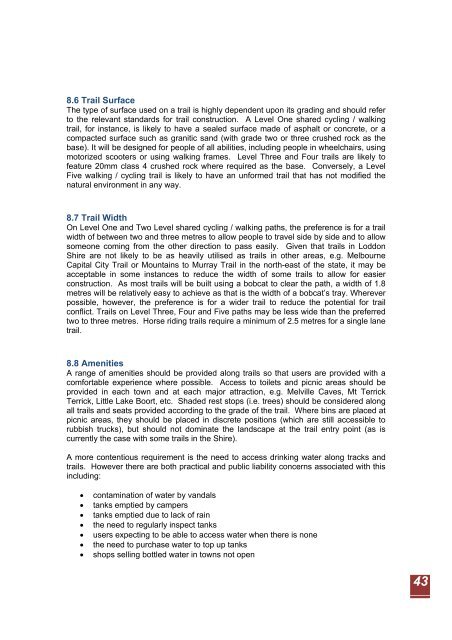Loddon Tracks and Trails Strategy - Loddon Shire Council
Loddon Tracks and Trails Strategy - Loddon Shire Council
Loddon Tracks and Trails Strategy - Loddon Shire Council
Create successful ePaper yourself
Turn your PDF publications into a flip-book with our unique Google optimized e-Paper software.
8.6 Trail Surface<br />
The type of surface used on a trail is highly dependent upon its grading <strong>and</strong> should refer<br />
to the relevant st<strong>and</strong>ards for trail construction. A Level One shared cycling / walking<br />
trail, for instance, is likely to have a sealed surface made of asphalt or concrete, or a<br />
compacted surface such as granitic s<strong>and</strong> (with grade two or three crushed rock as the<br />
base). It will be designed for people of all abilities, including people in wheelchairs, using<br />
motorized scooters or using walking frames. Level Three <strong>and</strong> Four trails are likely to<br />
feature 20mm class 4 crushed rock where required as the base. Conversely, a Level<br />
Five walking / cycling trail is likely to have an unformed trail that has not modified the<br />
natural environment in any way.<br />
8.7 Trail Width<br />
On Level One <strong>and</strong> Two Level shared cycling / walking paths, the preference is for a trail<br />
width of between two <strong>and</strong> three metres to allow people to travel side by side <strong>and</strong> to allow<br />
someone coming from the other direction to pass easily. Given that trails in <strong>Loddon</strong><br />
<strong>Shire</strong> are not likely to be as heavily utilised as trails in other areas, e.g. Melbourne<br />
Capital City Trail or Mountains to Murray Trail in the north-east of the state, it may be<br />
acceptable in some instances to reduce the width of some trails to allow for easier<br />
construction. As most trails will be built using a bobcat to clear the path, a width of 1.8<br />
metres will be relatively easy to achieve as that is the width of a bobcat’s tray. Wherever<br />
possible, however, the preference is for a wider trail to reduce the potential for trail<br />
conflict. <strong>Trails</strong> on Level Three, Four <strong>and</strong> Five paths may be less wide than the preferred<br />
two to three metres. Horse riding trails require a minimum of 2.5 metres for a single lane<br />
trail.<br />
8.8 Amenities<br />
A range of amenities should be provided along trails so that users are provided with a<br />
comfortable experience where possible. Access to toilets <strong>and</strong> picnic areas should be<br />
provided in each town <strong>and</strong> at each major attraction, e.g. Melville Caves, Mt Terrick<br />
Terrick, Little Lake Boort, etc. Shaded rest stops (i.e. trees) should be considered along<br />
all trails <strong>and</strong> seats provided according to the grade of the trail. Where bins are placed at<br />
picnic areas, they should be placed in discrete positions (which are still accessible to<br />
rubbish trucks), but should not dominate the l<strong>and</strong>scape at the trail entry point (as is<br />
currently the case with some trails in the <strong>Shire</strong>).<br />
A more contentious requirement is the need to access drinking water along tracks <strong>and</strong><br />
trails. However there are both practical <strong>and</strong> public liability concerns associated with this<br />
including:<br />
• contamination of water by v<strong>and</strong>als<br />
• tanks emptied by campers<br />
• tanks emptied due to lack of rain<br />
• the need to regularly inspect tanks<br />
• users expecting to be able to access water when there is none<br />
• the need to purchase water to top up tanks<br />
• shops selling bottled water in towns not open<br />
43


